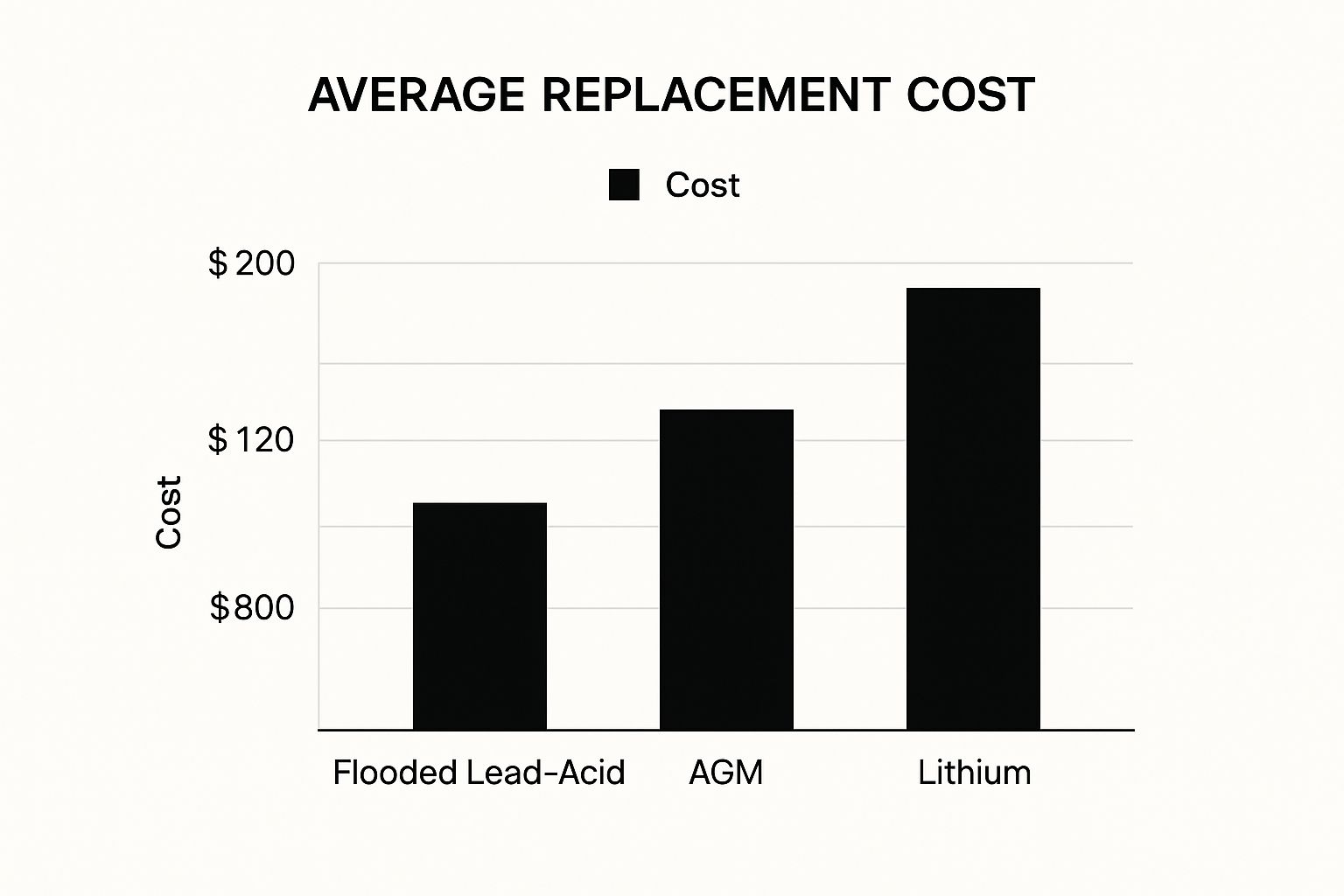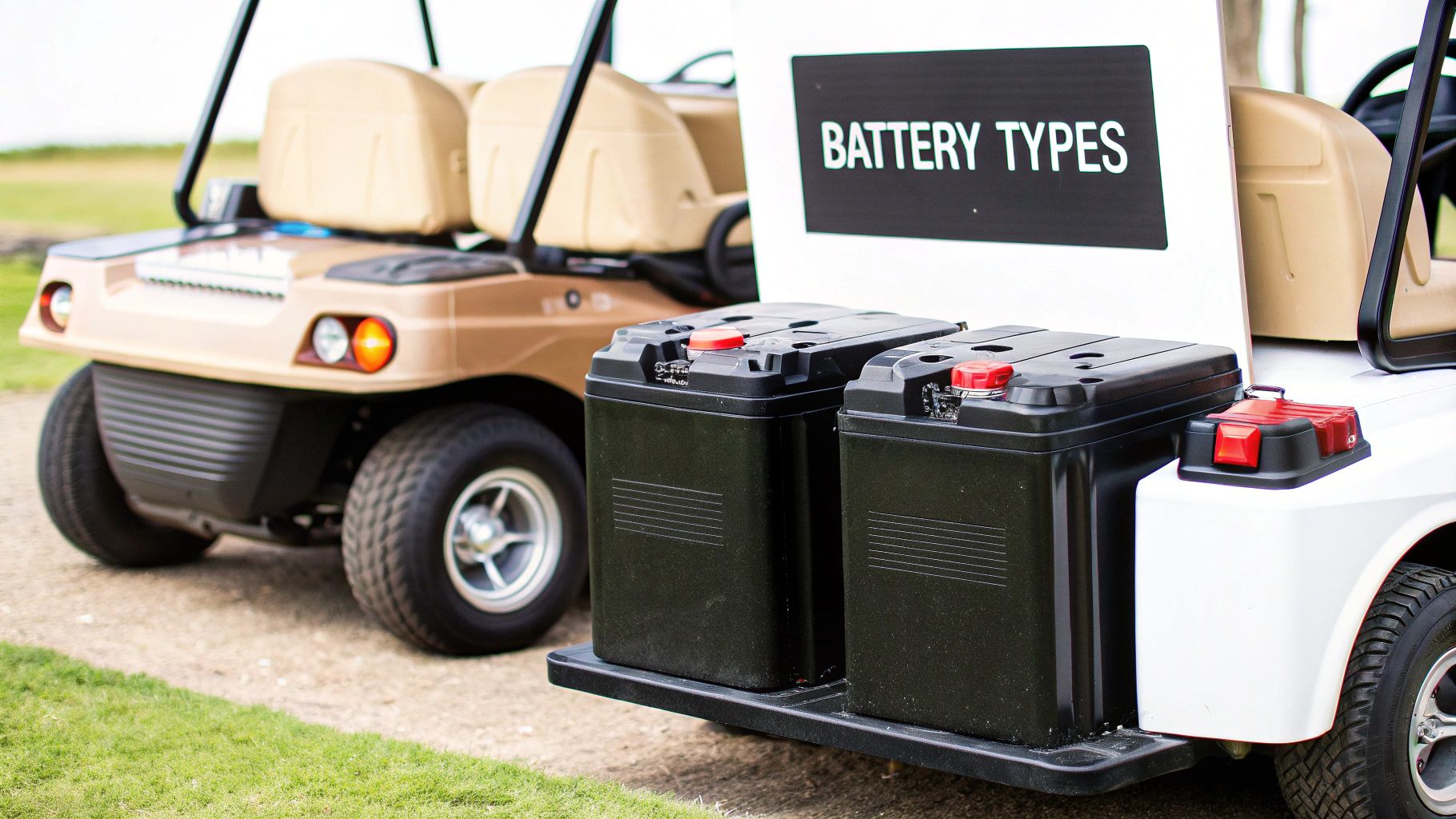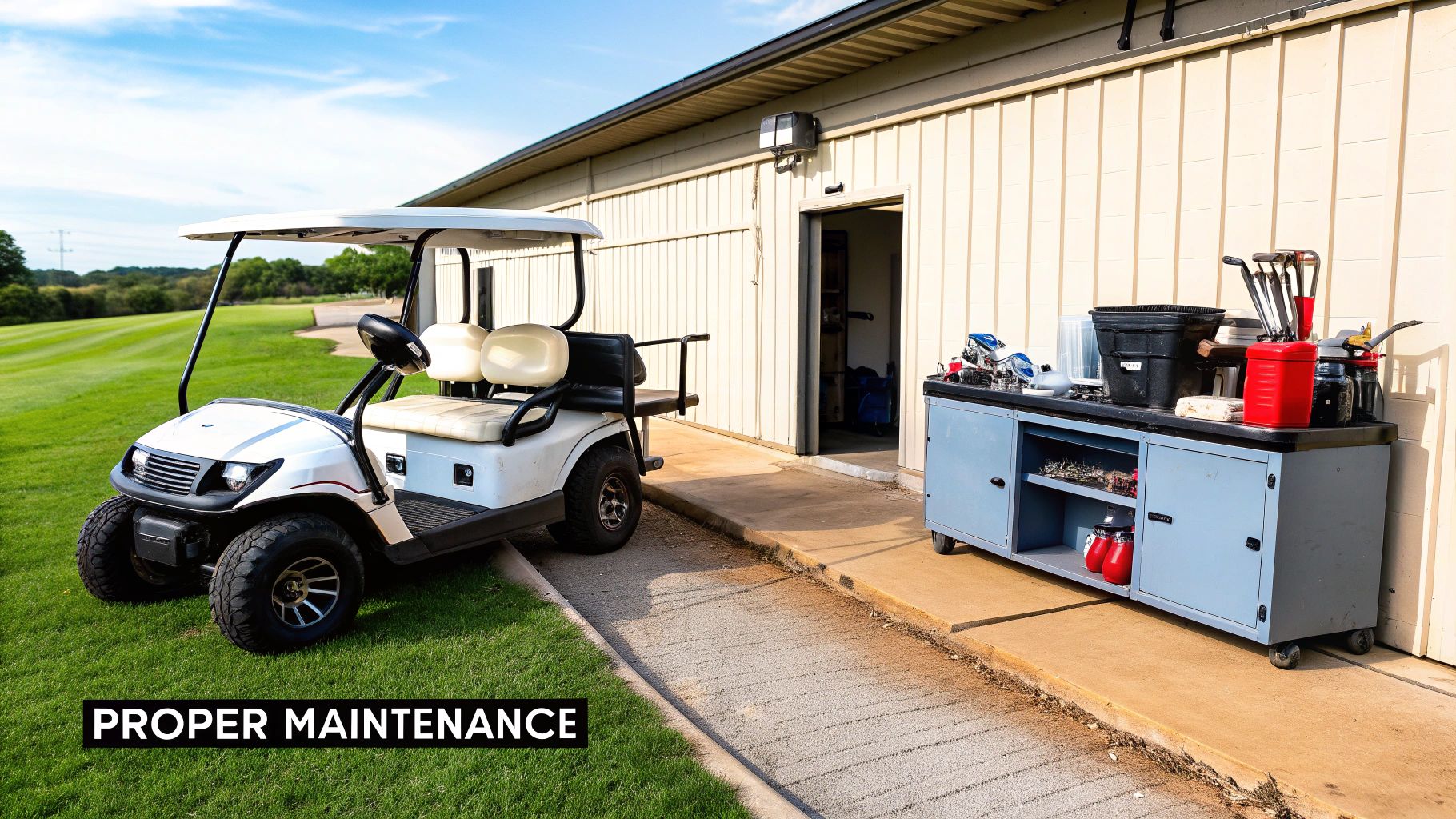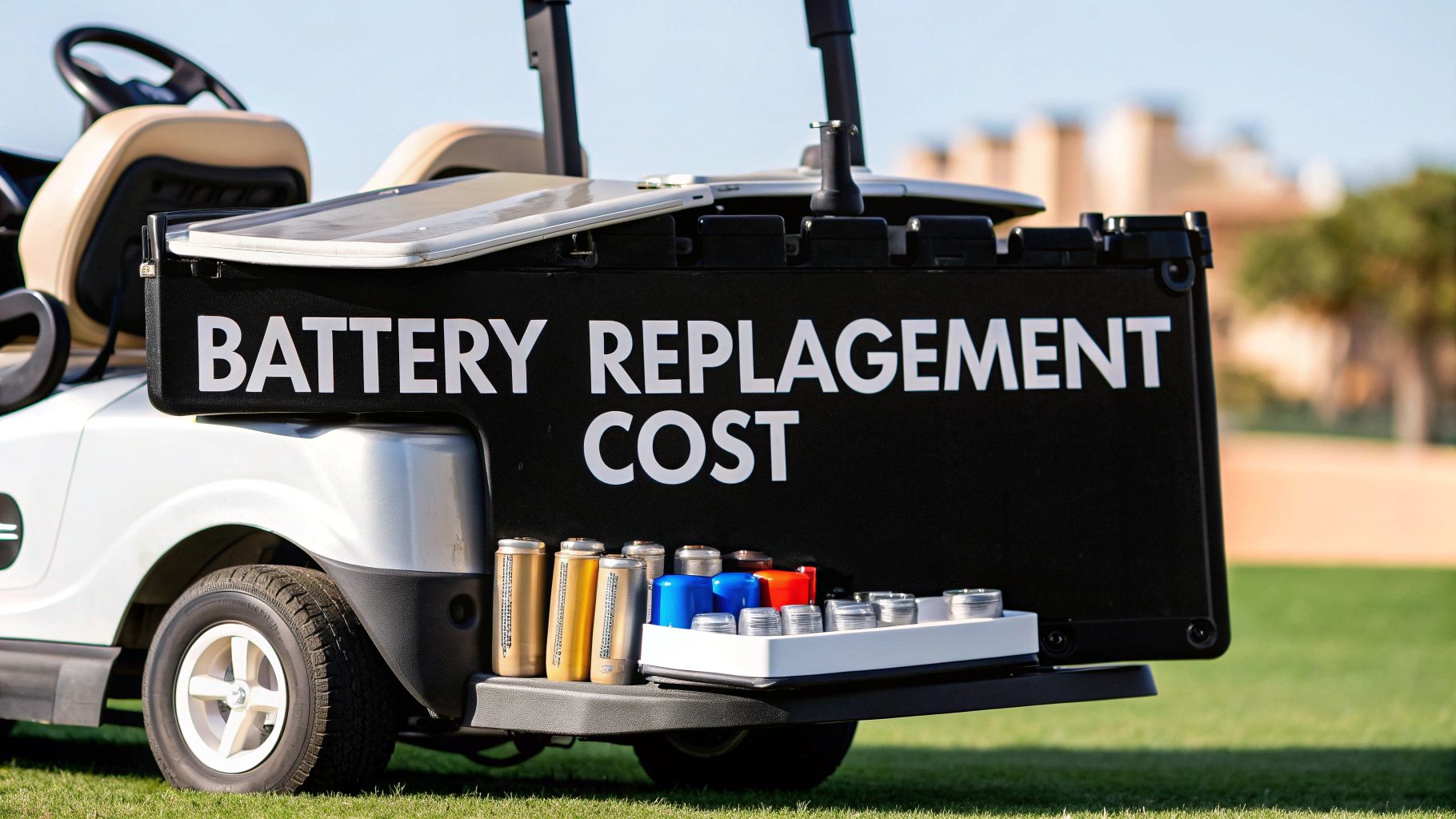When your golf cart starts to feel sluggish, struggling up hills or dying before you’ve even finished your round, the batteries are almost always the culprit. The typical golf cart battery replacement cost can be anywhere from $800 for a standard lead-acid set to over $2,000 for a premium lithium upgrade.
Your final bill will come down to the battery technology you choose and whether you decide to tackle the installation yourself or bring in a pro.
Understanding Your Quick Guide To Battery Replacement Costs
Facing a battery replacement can feel a little overwhelming, but getting a handle on the costs upfront makes the whole process much easier. It's best to think of the cost not as one fixed number, but as a spectrum. The price is shaped by three big factors: the type of battery, its performance, and the long-term value it offers.
The biggest driver of your golf cart battery replacement cost is the technology powering it. Your choice really boils down to a classic trade-off: save money now, or invest in benefits that pay off down the road?
The Three Tiers Of Battery Costs
Traditional flooded lead-acid batteries are the old standby. They're the most common and definitely the most affordable way to get back on the course, but they come with a catch—they need regular maintenance and have the shortest lifespan of the bunch.
One step up from there are AGM (Absorbent Glass Mat) batteries. These are sealed, which means no more checking water levels. They're completely maintenance-free and offer a longer life for a moderate bump in price.
At the top of the pyramid, you'll find lithium-ion batteries. While they have the highest initial cost, the advantages are huge. We're talking a much longer lifespan (often 3-5 times that of lead-acid), zero maintenance, faster charging, and a lighter weight that can noticeably improve your cart's speed and handling.
Key Insight: That initial sticker price doesn't tell the whole story. A cheaper battery set that needs to be replaced every couple of years can easily end up costing you more over a decade than a single, long-lasting lithium setup.
To give you a clearer picture, here’s a quick look at the average replacement costs for these three main battery types.

To make sense of these numbers, it helps to see a direct comparison of what you're getting for your money.
Battery Cost And Lifespan At A Glance
This table breaks down the initial investment against the long-term reality of owning each battery type.
| Battery Type | Average Replacement Cost (Full Set) | Typical Lifespan | Maintenance Level |
|---|---|---|---|
| Flooded Lead-Acid | $600 – $1,200 | 2–4 Years | High |
| AGM Lead-Acid | $800 – $1,500 | 4–6 Years | None |
| Lithium-Ion (LiFePO4) | $1,200 – $2,500+ | 8–10+ Years | None |
As the chart and table show, there’s a clear cost progression from lead-acid to lithium, which directly reflects the technology and performance you get. A standard lead-acid set might cost you between $600 to $1,200, while a modern lithium-ion setup known for its superior performance will run from $1,200 to $2,500. Don't forget, having a professional install them can add another $100 to $300 to the total.
For a deeper dive into these figures, you can explore the detailed cost breakdown from Vatrer Power's 2025 analysis.
Comparing The Main Golf Cart Battery Options
To really get a handle on the golf cart battery replacement cost, we need to pop the seat and look at the heart of your cart—the batteries themselves. The technology you pick here is the single biggest factor driving not just the final bill, but also your cart’s performance and how happy you are with it long-term.
Think of it like choosing between a trusty old pickup truck and a brand-new electric car. One is familiar and gets the job done but needs regular check-ups. The other is sleek, powerful, and pretty much runs on its own after you drive it off the lot. Let's break down the three main players.
Classic And Cost-Effective: Flooded Lead-Acid
Flooded lead-acid batteries are the traditional workhorses of the golf cart world. They’re the most common type you'll run into and have the lowest upfront cost, which makes them a go-to for many cart owners watching their wallets.

But that low price tag comes with a catch: they require consistent upkeep. You’ll need to pop the caps and top them off with distilled water every so often and keep the terminals clean to fend off corrosion. Skipping this maintenance is the quickest way to kill them, and they typically only last two to four years anyway. You can learn more about these essential tasks in our complete guide to golf cart battery maintenance.
The Maintenance-Free Middle Ground: AGM Batteries
If the idea of regular battery watering sounds like a chore you’d rather skip, then Absorbent Glass Mat (AGM) batteries are a fantastic middle-ground option. Since they are a type of sealed lead-acid battery, they are completely maintenance-free. No watering, no messy spills, and a much lower risk of corrosion.
You’ll pay a bit more for this convenience, but many owners find the peace of mind is well worth it. AGM batteries also tend to have a longer life than their flooded cousins, usually giving you solid power for four to six years. They strike a great balance between cost and convenience without jumping to the premium price of more advanced options.
The Premium Performer: Lithium-Ion (LiFePO4)
At the very top of the performance ladder, you'll find lithium-ion—specifically, Lithium Iron Phosphate (LiFePO4) batteries. These are the modern EV in our analogy. They're incredibly lightweight, pack a serious punch, and are virtually maintenance-free. Their effect on your cart is so much more than just holding a charge.
A lithium battery upgrade often feels like a full-cart performance enhancement, not just a simple parts swap. Your cart will feel quicker, climb hills with more authority, and maintain consistent power from a full charge down to empty.
The upfront cost is definitely the highest, but the long-term perks are huge. A full set of traditional lead-acid batteries for a 48V cart will run you somewhere between $800 and $1,500. A comparable lithium system, on the other hand, can range from $1,000 to over $3,000.
However, lithium batteries weigh 50% to 60% less, charge up to three times faster, and can last for a decade or more with zero maintenance. These advantages are making lithium an increasingly popular choice for cart owners who prioritize long-term value and an unbeatable ride.
Ultimately, picking the right battery is about balancing your budget today with what you want from your cart tomorrow. Whether you stick with the reliable lead-acid, go for the convenient AGM, or invest in high-performance lithium, understanding these differences is the key to making a smart financial decision.
Calculating The True Cost Of Ownership
The sticker price is just the start of the story when you're figuring out the real golf cart battery replacement cost. To make a smart financial move, you have to think beyond that first receipt and calculate the Total Cost of Ownership (TCO). This approach pulls back the curtain to show you the full financial picture over many years.
Think of it like buying a cheap printer. The machine itself might be a bargain, but the real expense sneaks up on you with those pricey ink cartridges. Golf cart batteries are no different. The "cheaper" lead-acid batteries can actually end up costing you a lot more in the long run because of how often they need to be replaced and maintained.

Breaking Down The 10-Year Costs
Let's run the numbers over a hypothetical 10-year period. We'll compare a cart running on old-school lead-acid batteries to one that's been upgraded to a modern lithium set. This isn't just about the initial purchase; it’s about every single dollar you'll spend to keep your cart rolling.
For the lead-acid scenario, you have to plan for more than just the first set of batteries. With a typical lifespan of only 2-4 years, you'll almost certainly need to buy at least two, if not three, full replacement sets over the decade.
Then there are the hidden costs that creep in:
- Maintenance Supplies: The constant need for distilled water and terminal cleaning supplies really adds up over time.
- Your Time: It's hard to put a price on your own time, but the hours you spend topping off water levels and cleaning terminals are worth something.
- Energy Use: Lead-acid batteries are simply less efficient. That means higher electricity bills every time you charge them compared to a lithium setup.
Taking this long-term view is essential for anyone wanting to make smarter transportation choices, whether it's for the golf course or just getting around the neighborhood. You can dive deeper into this topic in our guide to electric power carts.
Over a decade, a lithium battery's single purchase often proves more economical than the cycle of buying, maintaining, and replacing multiple sets of lead-acid batteries. The initial investment pays dividends in reliability and reduced long-term spending.
10-Year Ownership Cost Lead-Acid Vs Lithium
To really see the difference, let's put it all in a table. This hypothetical breakdown shows just how quickly the "cheaper" lead-acid option can become the more expensive headache.
| Expense Category | Lead-Acid Battery Costs | Lithium-Ion Battery Costs |
|---|---|---|
| Initial Purchase | $900 | $1,800 |
| Replacement 1 (Year 3) | $900 | $0 |
| Replacement 2 (Year 6) | $900 | $0 |
| Replacement 3 (Year 9) | $900 | $0 |
| Maintenance Supplies | $150 | $0 |
| Total 10-Year Cost | $3,750 | $1,800 |
The numbers don't lie. When you map it out, the lead-acid path could cost you nearly double over ten years. This is the exact reason the entire market is shifting.
What's more, the global lithium battery market is seeing prices fall, with an average cost now around $151 per kilowatt-hour (kWh). This trend is making these advanced batteries more affordable than ever. When you combine that with lifespans that can reach up to 10 years and handle 1,000 to 3,000 charge cycles, the value of lithium becomes impossible to ignore.
Deciding Between Professional And DIY Installation
Once you’ve picked out your new batteries, you’ve got another big decision to make, and this one directly impacts your total golf cart battery replacement cost. Are you going to roll up your sleeves and tackle the job yourself, or is it smarter to pay a pro for their time and expertise?
Each route has its own set of pros and cons, and the right choice really boils down to your budget, your skills, and how comfortable you are with electrical systems.
Hiring a pro is easily the simplest, most worry-free way to go. For a typical labor fee of $100 to $300, a qualified technician will handle the entire process from start to finish. This isn't just a matter of connecting a few wires. It includes all the heavy lifting, ensuring the wiring sequence is perfect, and safely disposing of your old, hazardous lead-acid batteries.
Even better, a professional installation almost always comes with a warranty on the labor. That gives you incredible peace of mind, knowing that if anything goes wrong because of the installation, you’re covered. For many cart owners, that assurance alone is well worth the extra cost.
The Trade-Offs Of A DIY Installation
On the flip side, the DIY approach has one massive, compelling advantage: you save money right away. By cutting out the labor fee, you can keep a few hundred dollars in your pocket. If you're mechanically inclined and already have the necessary tools, this is a seriously attractive option for lowering your overall expense.
However, those savings come with a few strings attached. First off, there’s the weight. A single lead-acid golf cart battery can weigh over 60 pounds, and you’ll be wrestling with a set of six or even eight of them. This is a physically demanding job that can easily lead to a strained back if you aren’t careful.
Safety First: Working with batteries involves very real risks. You're dealing with electrical systems that can spark, corrosive acid that can cause nasty burns, and the potential for dangerous short circuits if you connect things improperly. Safety gear like gloves and eye protection isn't optional—it's essential.
Are You Equipped For The Job?
Before you commit to doing it yourself, it's time for an honest gut check. A successful DIY battery swap takes more than just confidence.
Here’s a quick checklist to see if you're really prepared:
- Do you have the right tools? You’ll absolutely need a socket set, a good wrench, a wire brush for cleaning terminals, and ideally, a battery terminal puller.
- Are you comfortable with the physical demands? Lifting and maneuvering over 300 pounds of batteries is no joke.
- Do you understand the safety risks? Working with high-current electrical systems requires focus and care to avoid short circuits and personal injury.
- Do you have a plan for old battery disposal? You can't just toss old lead-acid batteries in the bin. They are hazardous waste and must be taken to a proper recycling facility, which is a service professionals usually include.
If you can confidently say "yes" to all of these, then a DIY replacement is a fantastic way to save some cash. But if you have any hesitation, especially when it comes to safety, paying for a professional service is a smart investment in both your cart and your well-being.
Actionable Tips To Lower Your Replacement Cost
A big replacement bill doesn't have to be a foregone conclusion. With a few smart moves, you can knock a significant amount off your next golf cart battery replacement cost without having to sacrifice quality or performance. These are the tried-and-true steps that can help keep more money in your wallet.

Your most powerful tool is simply shopping around. Never, ever take the first quote you get. Instead, make it a point to contact at least three different suppliers—this includes local battery shops, your golf cart dealership, and even online retailers. This one simple step can uncover price differences of several hundred dollars for the exact same set of batteries.
Shop Smart And Maintain Your Investment
Timing your purchase can also lead to some serious savings. Demand for batteries skyrockets during the peak golf season in spring and summer. If you plan ahead and buy during the off-season—think fall or winter—you’ll often find much better deals and promotions as shops look to clear out their inventory.
Also, try to look beyond just the lowest price tag. It's about finding real value. A slightly more expensive battery that comes with a solid 5-year warranty is a far better investment than a rock-bottom-priced one that gives up the ghost after two years, leaving you with no protection.
Pro Tip: Honestly, one of the best ways to save money is to put off buying new batteries altogether. Simple, consistent maintenance—like keeping lead-acid batteries properly watered and ensuring the terminals are clean—can easily add another year or more to their lifespan. That pushes back the replacement date and keeps cash in your pocket longer.
This same principle of investing in quality to boost your game applies to all your gear. If you're looking for other ways to upgrade your time on the course, take a look at our guide on the top 7 battery-powered carts to upgrade your game in 2025.
Finally, don't just toss your old batteries, especially if they're the lead-acid type. Those old units still have some value left in them.
- Recycle for Cash: Most auto parts stores and local scrapyards will actually pay you for your old lead-acid batteries. The scrap value is determined by the weight of the lead inside.
- Offset Your Cost: It won’t be a massive windfall—you might get $5 to $15 per battery—but it's an easy way to chip away at the cost of your new set. It's a satisfying way to get a little money back while making sure those hazardous materials are handled correctly.
Common Questions About Golf Cart Batteries
Even after breaking down all the numbers, it’s completely normal to have a few more questions pop up. The world of golf cart batteries has its own quirks, and getting straight answers can make all the difference as you decide on the right golf cart battery replacement cost and technology for your needs. This FAQ is here to clear up those common points of confusion.
Can I Mix Different Brands Or Ages Of Golf Cart Batteries?
The short answer here is a hard no. It's a really common temptation to try and save a few bucks by only replacing the one or two batteries that have clearly failed, but trust me, this is a strategy that will backfire every single time.
Think of your battery pack like a team of rowers in a boat. If one rower gets tired and slows down, the others have to pull harder to pick up the slack. Before you know it, the whole team is exhausted. Mixing old and new batteries—or even different brands—creates that same kind of imbalance. The newer, stronger batteries are forced to overwork to compensate for the weaker ones, causing them to wear out much, much faster. Always replace all your batteries at once with a matching set of the same brand, type, and age to keep your pack working in perfect harmony.
How Do I Know When My Golf Cart Batteries Need Replacing?
Your cart will almost always give you a few clear warning signs that its power source is on its last legs. The most obvious signal is a major drop in range; you'll notice a full charge just doesn't get you as far as it used to.
Other telltale signs include:
- Reduced Power: The cart really struggles to climb hills that it used to handle with ease.
- Slow Charging: It takes significantly longer to reach a full charge.
- Visible Damage: You might see cracks, swelling, or even leaking acid on the battery casings themselves.
For a definitive diagnosis, a battery load tester is your best friend. This tool measures a battery's ability to perform under pressure, giving you a clear yes-or-no answer on whether it's still healthy or ready for retirement.
Key Takeaway: While a lithium battery's upfront cost is higher, it often pays for itself. You might buy one lithium battery in the time you'd need to purchase, maintain, and replace three or four lead-acid sets.
Is Upgrading To A Lithium Battery Worth The Extra Cost?
For the vast majority of cart owners, the answer is a resounding yes. While the initial investment is definitely higher, the long-term math almost always works out in lithium's favor. A quality lithium battery can last up to 10 years, whereas you’ll be lucky to get three years out of a typical lead-acid set.
Beyond just the lifespan, lithium batteries are completely maintenance-free (no more checking water levels!), they charge much faster, and they're significantly lighter, which can give your cart’s overall performance a nice little boost. If you plan on keeping your cart for several years and really value convenience and power, the long-term savings make lithium a very smart investment.
How Do I Figure Out My Golf Cart's Voltage?
Figuring out your cart's voltage is actually simpler than it sounds. Just pop open the seat and take a look at one of the batteries. Count the number of plastic water-fill caps on top of it.
Now, just multiply that number by two—that gives you the voltage of a single battery. For example, three caps mean it's a 6-volt battery (3 x 2 = 6V). To get the total system voltage, count the total number of batteries in the cart and multiply the two numbers together. If you have six 6-volt batteries, you have a 36-volt system (6 batteries x 6V = 36V). Easy as that.
Ready to make your round of golf easier and more enjoyable? The Caddie Wheel offers a simple, powerful electric assist for your existing push cart, letting you walk the course without the strain. Enjoy up to 36 holes on a single charge and focus on your game, not the effort. Upgrade your game with Caddie Wheel today!


Share:
A Guide to Golf Cart Battery Maintenance
6 Essential Golf Cart Maintenance Tips for 2025